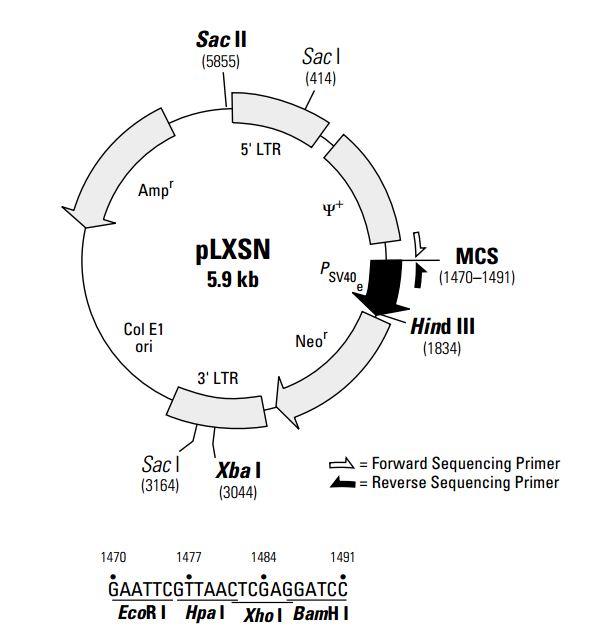pLXSN 载体
| 质粒类型: | 逆转录病毒载体 |
|---|---|
| 载体大小: | 5874 bp (查看载体序列) |
| 5' 测序引物及序列: | 5'-CCCTTGAACCTCCTCGTTCGACC–3' |
| 3' 测序引物及序列: | 5'-GAGCCTGGGGACTTTCCACACCC–3' |
| 载体抗性: | Ampicillin (氨苄青霉素) |
| 筛选标记: | Neomycin (新霉素) |
pLXSN contains elements derived from Moloney murine leukemia virus (MoMuLV) and Moloney murine sarcoma virus (MoMuSV), and is designed for retroviral gene delivery and expression (1–3). Upon transfection into a packaging cell line, pLXSN can transiently express, or integrate and stably express, a transcript containing Y+ (the extended viral packaging signal) the gene of interest, and a selectable marker. The 5' viral LTR in this vector contains promoter/enhancer sequences that control expression of the gene of interest in the multiple cloning site. The SV40 early promoter (PSV40e) controls expression of the neomycin resistance gene (Neor), which allows antibiotic selection in eukaryotic cells. pLXSN also includes the Col E1 origin of replication and E. coli Ampr gene for propagation and antibiotic selection in bacteria.
载体应用
As a part of the Retro-X™ System pLXSN can be transfected into a packaging cell line such as the RetroPack™ PT67 Cell Line . Once in the cell, RNA from the vector is packaged into infectious, replication-incompetent retroviral particles. pLXSN does not contain the structural genes (gag, pol, and env) necessary for particle formation and replication, however, these genes are stably integrated into PT67 (4–7). Subsequent introduction of pLXSN, containing Y+ (psi), transcription and processing elements, and the gene of interest produces high-titer, replication-incompetent infectious virus. That is, these retroviral particles can infect target cells and transmit the gene of interest (which is cloned between the viral LTR sequences), but cannot replicate within these cells since the cells lack the viral structural genes. The separate introduction and integration of the structural genes into the packaging cell line minimizes the chances of producing replication-competent virus due to recombination events during cell proliferation.


